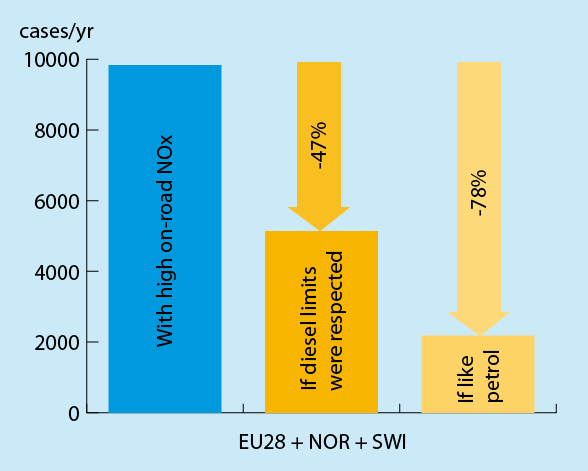Every year about 7,500 lives could have been saved in the EU if diesel cars had emitted as little NOx as petrol cars.
Over the last 25 years, the share of diesel cars in the EU increased dramatically, from 15 to more than 50 per cent of new car sales. There are now more than 100 million diesel cars running in the EU, twice as many as in the rest of the world together.
Despite the introduction of gradually stricter EU emission standards, emissions of nitrogen oxides (NOx) from diesel cars are significantly higher than those from petrol cars. In fact, in real-world driving, diesel car NOx emissions are even much higher than in the official certification tests – on average emissions on the road are four to seven times higher.
In a new study, researchers at the International Institute for Applied Systems Analysis (IIASA) and the Norwegian Meteorological Institute (NMI) have calculated the premature deaths from these excess NOx emissions for the population in all EU countries plus Norway and Switzerland in 2013.
NOx is a precursor to fine particulate matter (PM2.5), which is a key health-damaging air pollutant responsible for more than 400,000 premature deaths annually in the EU28, Norway and Switzerland. The study estimates that roughly 10,000 premature deaths annually can be attributed to NOx emissions from diesel cars, vans and light commercial vehicles. About half – around 5,000 premature deaths annually – are due to NOx emissions being much higher than limit values in real-world driving.
Excess concentrations of nitrogen dioxide (NO2) can also have direct health impacts, but as these to some extent overlap with the impacts from PM2.5, they were not included in the analysis.
The countries with the highest number of premature deaths attributable to PM2.5 from diesel cars’ NOx emissions are Italy, Germany and France, due to the high number of diesel cars and their large populations. However, the risk per capita varies between countries and is almost twice as high in Italy as in France.
“Had diesel cars met the EU emission standards, almost 5,000 premature deaths per year could have been avoided,” said Jens Borken-Kleefeld, transportation expert at IIASA. “And if diesel car NOx emissions were as low as those from petrol cars, about 7,500 premature deaths per year could have been avoided.”
The authors point out that they believe that the calculated impacts are probably a lower estimate, because recent findings indicate that the officially reported NOx emissions from diesel cars are likely to be revised upwards.
It should be noted that road transport contributes about 40 per cent of total NOx emissions in the EU, and the high NOx emissions from diesel cars is one of the main reasons why several countries, including Germany, France, Austria, Belgium and Ireland, consistently have failed to achieve their binding national emission ceilings under the EU’s NEC directive and the Gothenburg Protocol.
Moreover, exceedances of the EU air quality limits for NO2 occur mostly in heavily trafficked areas and have to a large part been attributed to emissions from diesel vehicles.
Christer Ågren
Source: IIASA News, 18 September 2017.
The study: “Impact of excess NOx emissions from diesel cars on air quality, public health and eutrophication in Europe.” By J.E. Jonson, J. Borken-Kleefeld J, D. Simpson, A. Nyiri, M. Posch, and C. Heyes. 2017. Environmental Research Letters 12: e094017. DOI:10.1088/1748-9326/aa8850
 Figure: Premature deaths caused by NOx emissions from diesel cars, vans and light commercial vehicles in the EU plus Norway and Switzerland.
Figure: Premature deaths caused by NOx emissions from diesel cars, vans and light commercial vehicles in the EU plus Norway and Switzerland.































